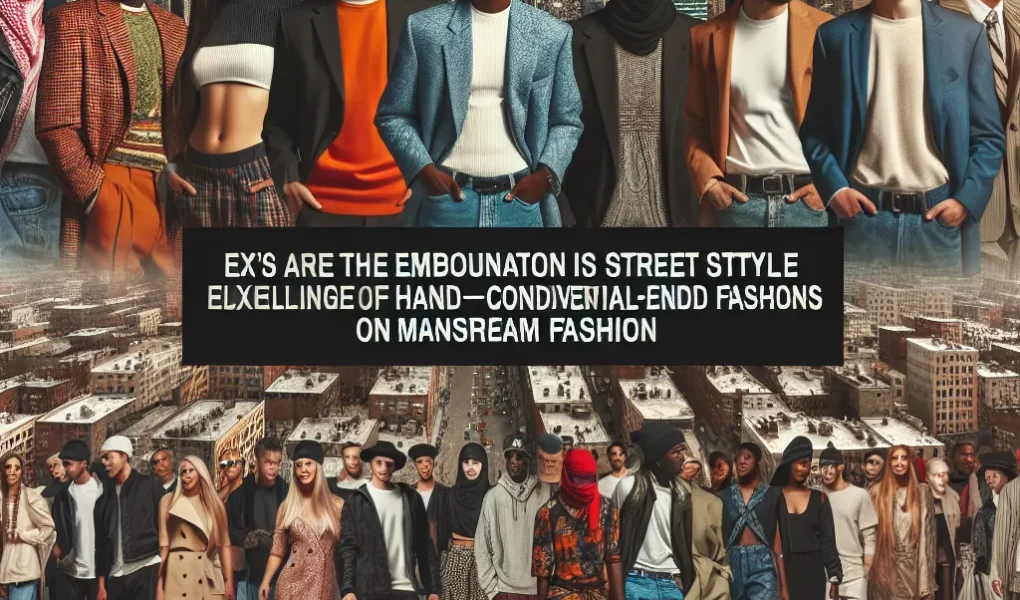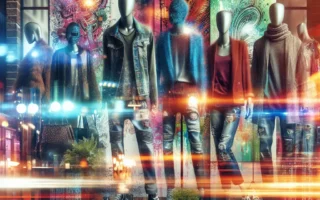The History of Street Style
Street style has undoubtedly had a significant influence on current fashion trends, shaping the way people express themselves through clothing. To understand the roots of this impact, it’s important to dive into the history of street style. The concept of street style emerged in the 20th century, particularly gaining momentum in the 1950s and 1960s as youth subcultures started to express themselves through fashion in urban environments.
During the 1970s and 1980s, street style began to evolve as a form of self-expression and rebellion against mainstream fashion norms. Punk rock, hip-hop, and skateboarding cultures played a pivotal role in shaping street style during this period. This era marked the rise of DIY fashion, bold graphics, and a mix of high and low-end fashion pieces, all of which have left a lasting impact on contemporary fashion trends.
In the 1990s, the globalization of street style became more apparent as subcultures, fueled by music, art, and social movements, intermingled across different regions and cities worldwide. This cross-pollination of styles led to the diversification and hybridization of street fashion, further solidifying its influence on mainstream trends.
Fast forward to the present day, and street style continues to be a driving force in fashion, with social media and digital platforms accelerating its reach and impact. Today, designers and brands draw inspiration from street fashion, and fashion enthusiasts look to street style icons and influencers for cues on how to curate their looks.
In conclusion, the history of street style underscores its profound impact on current fashion trends, acting as a mirror of societal movements, individuality, and cultural shifts. Understanding this lineage is crucial in recognizing the enduring relevance of street style in shaping the fashion landscape.
Evolution of Street Style
Street style has always been a powerful force driving fashion trends, constantly evolving and shaping the way we express ourselves through clothing. The influence of street style on current fashion trends is undeniable, as it reflects the cultural and social changes taking place around us. Over the years, street style has transformed from being an underground subculture to a mainstream phenomenon that heavily impacts the fashion industry.
The evolution of street style can be traced back to the rebellious and non-conformist attitudes of youth subcultures in the 20th century. From the punk rock movement of the 1970s to the hip-hop culture of the 1980s and 90s, street style has absorbed elements from various countercultural movements, constantly reinventing itself along the way. The DIY ethos of punk gave rise to distressed denim, leather jackets, and unconventional hairstyles, while the hip-hop scene popularized baggy silhouettes, bold logos, and sportswear-inspired ensembles.
With the advent of social media and digital platforms, street style has become more accessible and influential than ever. Fashion bloggers, influencers, and street photographers have played a pivotal role in propelling street style onto the global stage, turning everyday individuals into style icons. This democratization of fashion has led to a fusion of high and low, as luxury brands incorporate elements of streetwear into their collections, and streetwear labels collaborate with high-end designers.
As a result, street style has infiltrated the runway, blurring the lines between fashion insiders and the general public. Today, it serves as a barometer of society, reflecting the societal shifts, political movements, and cultural moments that shape our world. The evolution of street style continues to inspire and redefine current fashion trends, serving as a visual playground for self-expression and diversity.
Street Style Icons
Street style has become a major influencer in current fashion trends, with street style icons playing a significant role in shaping the way we dress. These individuals, often spotted at fashion weeks, music festivals, and on the streets of major cities, have a unique ability to blend high and low fashion in a way that resonates with people around the world.
Street style icons like Rihanna, A$AP Rocky, and Bella Hadid effortlessly mix luxury brands with thrifted pieces and emerging designers, creating looks that are both aspirational and attainable. Their fearless approach to fashion has inspired countless trends, from chunky sneakers and oversized blazers to sportswear as everyday wear.
What sets street style icons apart is their authenticity and willingness to take risks. They embody the idea that fashion is a form of self-expression, and their ensembles often reflect their personalities and individuality. This genuine approach to style has resonated with a global audience, making them trendsetters in their own right.
In the age of social media, street style icons have become even more influential. Their curated Instagram feeds and paparazzi shots serve as daily sources of inspiration for fashion enthusiasts, further solidifying their impact on current fashion trends. As a result, brands are increasingly looking to collaborate with these icons, recognizing the value they bring in reaching and engaging with diverse audiences.
Overall, street style icons play a pivotal role in shaping the current fashion landscape, demonstrating that style is not confined to runways and designer labels but is instead a reflection of individual creativity and attitude.
Impact of Street Style on Fashion Industry
Street style has become a significant influence on current fashion trends, impacting the fashion industry in profound ways. The rise of street style as a trendsetter can be attributed to the democratization of fashion through social media and the internet. In the past, fashion trends were predominantly dictated by high-end designers and runway shows. However, with the advent of social media platforms like Instagram and fashion blogs, street style has emerged as a powerful force in shaping the industry.
Street style is characterized by its authenticity and individuality, often reflecting the personal expression and unique fashion sensibilities of individuals. Fashion influencers and bloggers, who gained popularity through their distinct street style, have become pivotal in driving fashion trends and shaping consumer preferences. By showcasing their daily outfits and unique styling choices, these influencers have garnered loyal followings and have the ability to sway consumer behavior and purchasing decisions.
The impact of street style on the fashion industry is undeniable, as designers and brands increasingly look to street fashion for inspiration and to understand consumer demands. Street style has propelled the “casualization” of high fashion, blurring the lines between luxury and streetwear. Moreover, street style has influenced the way fashion is presented, with many brands incorporating urban elements and non-traditional models in their campaigns and runway shows.
In conclusion, street style has redefined the fashion landscape, bringing about a shift in power from traditional fashion elites to the streets. The authenticity and diversity associated with street style have reshaped current fashion trends and will continue to have a lasting impact on the fashion industry moving forward.
Street Style Trends Around the World
Street style has become a major influence on current fashion trends, with its impact felt around the world. From the vibrant and eclectic looks seen on the streets of Tokyo to the effortlessly cool and edgy styles of New York City, street style trends vary widely depending on the location. In Tokyo, for example, there is a strong emphasis on mixing and matching bold colors and patterns, while New York City embraces a more minimalist and urban aesthetic with a focus on sleek silhouettes and statement accessories.
In London, street style trends often reflect a mix of high fashion and subculture influences, resulting in an eclectic and avant-garde approach to dressing. Paris, on the other hand, is known for its timeless elegance and understated chic, with an emphasis on classic pieces and sophisticated ensembles. Meanwhile, in cities like Seoul and Berlin, street style trends are characterized by their experimental and boundary-pushing nature, often blending elements of streetwear with high fashion in unexpected ways.
These diverse street style trends from around the world not only reflect the unique cultural and social influences of each city but also serve as a source of inspiration for designers, influencers, and fashion enthusiasts globally. The global impact of street style on current fashion trends is undeniable, with its ability to constantly evolve and shape the way we approach and interpret fashion.
Incorporating Street Style into High Fashion
Incorporating street style into high fashion has been a significant trend in the fashion industry in recent years. Street style, characterized by its edgy, urban, and individualistic aesthetic, has made a strong impact on current fashion trends, influencing designers, fashion houses, and even retail brands. The fusion of street style into high fashion has blurred the lines between traditional runway looks and everyday wear, creating a more dynamic and inclusive approach to fashion.
One of the key aspects of incorporating street style into high fashion is the emphasis on individuality and self-expression. Street style celebrates diversity and encourages personal interpretation, which challenges the conventional norms of high fashion. Designers are increasingly drawing inspiration from street fashion, integrating elements such as oversized silhouettes, sportswear influences, and unconventional styling techniques into their collections. This infusion of street-inspired elements has brought a fresh and unexpected dimension to high fashion, resonating with a broader audience.
Moreover, the rise of social media and digital platforms has propelled the influence of street style on high fashion. Street style influencers and fashion bloggers, with their distinctive and authentic approach to dressing, have become instrumental in shaping trends and driving consumer preferences. Their ability to effortlessly mix luxury pieces with casual streetwear has redefined the notion of high-end fashion, making it more accessible and relatable to a global audience.
As a result, the boundaries between street style and high fashion have become increasingly fluid, giving rise to a new hybrid fashion landscape. Streetwear brands collaborating with high-end labels, luxury houses featuring urban-inspired pieces in their collections, and runway models showcasing a more laid-back, street-infused look are all indicative of this convergence. The evolution of street style into high fashion signifies a shift towards a more inclusive, diverse, and eclectic sartorial expression, reflecting the changing attitudes and lifestyles of contemporary fashion enthusiasts.
Future of Street Style in Fashion
As street style continues to be a dominant force in shaping contemporary fashion trends, it is essential to consider its future trajectory in the ever-evolving world of fashion. The influence of street style on current fashion trends is undeniable, as it reflects the dynamic and diverse expressions of individuality among urban youth and beyond. Looking ahead, the future of street style in fashion is poised to further revolutionize the industry, embracing sustainability, inclusivity, and technological innovation.
Sustainability is anticipated to play a pivotal role in the future of street style, with an increasing emphasis on eco-friendly materials, ethical production processes, and the repurposing of vintage and second-hand clothing. This shift towards sustainability aligns with the growing conscientiousness of consumers and the industry’s commitment to reducing its environmental impact.
Furthermore, the future of street style in fashion will continue to champion inclusivity by celebrating diversity in body shapes, gender identities, and cultural backgrounds. Fashion brands and designers are progressively embracing a more inclusive approach, recognizing the beauty and power of representation in their collections and campaigns.
Moreover, technological innovation is set to propel the future of street style, with the integration of virtual and augmented reality, interactive shopping experiences, and digital clothing. These advancements will redefine the way individuals engage with fashion, blurring the lines between physical and digital expressions of style.
In conclusion, the future of street style in fashion holds tremendous potential for driving positive change and creativity within the industry. As sustainability, inclusivity, and technological innovation continue to shape the landscape of fashion, street style will undoubtedly remain a influential force, continually pushing boundaries and redefining the way we perceive and experience fashion.



